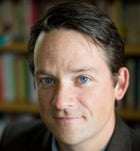Yesterday afternoon, the Associated Press detailing the contents of , the highly anticipated Lance Armstrong tell-all written by former U.S. Postal Service teammate Tyler Hamilton and longtime ���ϳԹ��� contributing editor Daniel Coyle. The book is due in stores September 5, but given the hype surrounding its release, it’s no surprise that the publisher’s armor of secrecy was pierced. What is surprising is how badly the initial report fumbled the material.
 Dan Coyle.
Dan Coyle. Lance Armstrong gives an interview at the 2010 Tour de France.
Lance Armstrong gives an interview at the 2010 Tour de France.Thursday’s AP story, published under the ho-hum headline “Tyler Hamilton Says Lance Armstrong Supplied Blood Booster Before ’99 Tour,” offers a shockingly dull overview of Hamilton’s allegations. The book “covers much of what Hamilton said in a ” the story states, written in AP’s classic voice-from-nowhere tone. Reading it, you’re left with the impression that The Secret Race is “just” a rehash of what Hamilton had told us already and that Armstrong had dodged yet another bullet—maybe the last one in the chamber.
I also got a copy of The Secret Race this week, and ���ϳԹ��� had made plans to review it on the day the book became available. When I saw the AP story, I imagine I had the same reaction many other journalists had who’d received a review copy: Did the AP read the same thing I just did?
Here’s the reality: The Secret Race isn’t just a game changer for the Lance Armstrong myth. It’s the game ender. No one can read this book with an open mind and still credibly believe that Armstrong didn’t dope. It’s impossible. That doesn’t change the fact that he survived cancer and helped millions of people through Livestrong, but the myth of the clean-racing hero who came back from the dead is, well, dead.
Where to start? It’s hard to describe the impact of The Secret Race by boiling it down to seven or eight shocking anecdotes. The book delivers them—make no mistake—but its real power comes from Hamilton’s unprecedented attempt at full disclosure. And I mean full. The book is the holy grail for disillusioned cycling fans in search of answers. In a taut 268 pages, Hamilton confidently and systematically destroys any sense that there was ever any chance of cleaning up cycling in the early 2000s, revealing the sport’s powerful and elaborate doping infrastructure. He’s like a retiring magician who has decided to let the public in on the profession’s most guarded techniques.
Beginning with his first doping experiences as a member of the U.S Postal Service team in 1997, Hamilton reveals not only what he and other riders were doing and taking (EPO, steroids, testosterone, Actovegin, blood transfusions, and on and on), but also how they were taking it (in the case of EPO, intravenously—and Hamilton has the scar to prove it). He tells us how most riders evaded detection (one trick: French laws bar testers from showing up between 10 p.m. and 6 a.m., so cyclists “microdosed” EPO at ten and the drug was gone by morning) and how the game was rigged in a way that made testing nearly irrelevant (“If you were careful and paid attention,” writes Hamilton, “you could dope and be 99 percent certain that you would not get caught”). Supporters still clinging to the claim that Armstrong passed more than 500 drug controls will be shocked to learn how insignificant those tests really were.
Not that all this doping and evading was a cinch. Hamilton describes the exhausting deceptions and logistics required to obtain the drugs, hide the drugs, store the blood bags, schedule the dosing—the hundreds of details necessary to maintain the high-40s hematocrit level that keeps a racer competitive on the course and safe in the control room. At times the evasive measures sound like techniques from a cheap spy novel. There are disguises, prepaid cell phones, clandestine meet-ups in random hotel rooms, and lots and lots of code names, including “red eggs” (testosterone pills), “Edgar” (EPO), and “oil” (testosterone drops). At one point, Hamilton got a text from his doctor on his prepaid phone during a Tour de France rest day: “The restaurant is 167 miles away.” Translation: Meet me in room 167 for your blood transfusion.
The drugs are everywhere, and as Hamilton explains, Armstrong was not just another cyclist caught in the middle of an established drug culture—he was a pioneer pushing into uncharted territory. In this sense, the book destroys another myth: that everyone was doing it, so Armstrong was, in a weird way, just competing on a level playing field. There was no level playing field. With his connections to Michele Ferrari, the best dishonest doctor in the business, Armstrong was always “two years ahead of what everybody else was doing,” Hamilton writes. Even on the Postal squad there was a pecking order. Armstrong got the superior treatments.
What ultimately makes the book so damning, however, is that it doesn’t require readers to put their full faith in Hamilton’s word. In the book’s preface, which details its genesis, Coyle not so subtly addresses Armstrong’s supporters by pointing out that, while the story is told through Hamilton, nine former Postal teammates agreed to cooperate with him on The Secret Race, verifying and corroborating Hamilton’s account. Nine teammates. That fact is the first punch thrown at Armstrong’s supporters—and it might be the most damaging one. Next Wednesday, when The Secret Race comes out, backers will probably make the familiar claim that Hamilton is a disgruntled, bitter ex-rival who got popped for doping and is now looking to cash in. But that doesn’t explain why nine former teammates agreed to cooperate.
A sampling of the book’s revelations:
* In 1999, Postal hired Armstrong’s gardener, nicknamed Motoman, to follow the Tour in a motorcycle, carrying a thermos full of EPO and a prepaid cell phone. “When we needed ‘Edgar,’” writes Hamilton, “Phillipe would zip through the Tour’s traffic and make a drop-off.”
* Armstrong has always tried to downplay his relationship to Ferrari, but Hamilton and other teammates describe him as being obsessed with the man. “Kevin [Livingston] and I used to say that Lance said the word ‘Michele’ more often than he said ‘Kik,’ ” says Hamilton, referring to Armstrong’s nickname for his wife at the time, Kristen. Multiple teammates, including Christian Vande Velde, Jonathan Vaughters, and Floyd Landis recount how strange it was to hear Chris Carmichael described in the press as Lance’s coach. “I don’t recall Lance ever mentioning Chris’ name or citing a piece of advice Chris had given him,” writes Hamilton. “By contrast, Lance mentioned Ferrari constantly, almost annoyingly so.” Landis is more pointed, calling Carmichael “a beard.”
* The 2011 60 Minutes story on Armstrong’s doping reported that he had once failed a drug test in 2001 at the Tour of Switzerland, a story Hamilton backs up: “Yes, Lance Armstrong tested positive at the Tour of Switzerland.” He describes an encounter with Armstrong just after Stage 9 of the race. “You won’t fucking believe this,” he allegedly told Hamilton. “I got popped for EPO.” According to the 60 Minutes investigation, the UCI stepped in after the positive test, requesting that “the matter go no further,” and then set up a meeting between the lab’s director, Armstrong, and team director . The insinuation is clear: Lance was using connections within the UCI to help his cause. Hamilton describes a climate in which this doesn’t seem at all far-fetched. “Sometime after that, I remember Lance phoning Hein Verbruggen from the team bus … and I was struck by the casual tone of the conversation. Lance was talking to the president of the UCI, the leader of the sport. But he may as well have been talking to a business partner, a friend.”
These kinds of stories are everywhere in the book, and it almost seems silly to catalog them. The book’s power is in the collected details, all strung together in a story that is told with such clear-eyed conviction that you never doubt its veracity. Hamilton describes a doping culture that is so pervasive that one loses track of all the players involved in keeping the fraud going: doctors, coaches, trainers, soigneurs, politicians, wives. When a drug tester shows up in a town full of cyclists, the word spreads through the community within minutes, tipping off anyone who might still be in their “glowtime” (the period when drugs in their system are still detectable).
Sometimes the authorities couldn’t be anticipated, but there was always someone to help cover for a vulnerable cyclist. For Hamilton, that was his long-suffering ex-wife, Haven. When a tester would show up unexpectedly at their home, Haven would lock eyes with Hamilton and ask, “You’re good?” before answering the door. Most of the time he was. Once, when he wasn’t, they both hit the deck and stayed quiet until the tester left the premises.
This is a world that disgruntled cycling fans have long suspected existed, but the reality is so much more elaborate than we could have imagined. Lies upon lies upon lies. And everyone in on the secret. It’s the weight of all those secrets that inevitably takes its toll on Hamilton and his teammates. No one understands the burden of maintaining a double life more than Hamilton, a once proud cyclist whose career and private life went off the rails the moment he failed a test after his gold-medal performance at the 2004 Olympics. In the book’s preface, describes his first meeting with the disgraced cyclist, in a booth at the back of a restaurant in Boulder, Colorado, in 2011. As they sat down, Hamilton looked like he was going to cry—“not from grief,” writes Coyle, “but from relief.”
“Sorry,” Hamilton says. “It just feels so good to be able to talk about this, finally.”
This exchange establishes the real arc of the book, which is less about destroying Armstrong and more about rehabilitating Hamilton—not for fans, necessarily, but for himself. The Hamilton that viewers saw on 60 Minutes was nervous and visibly conflicted about his decision to come clean and tell the truth. The Hamilton in The Secret Race is a different being altogether. It may just be the strength of Coyle’s writing, but the more Hamilton reveals—the more exhaustive his accounting of all the sins—the more confident his voice becomes. You sense the weight of all the lies being shed, chapter by chapter. By the end, Hamilton has journeyed so far beyond a mere thirst for revenge that he confesses that he feels sorry for Armstrong—a teammate who once tried to destroy him. He understands the pain involved with keeping the lies going for so long.
“I was sorry in the largest sense,” he writes, describing his emotions this past summer when he stared at a photo of Armstrong that he found in his garage. “Sorry for him as a person, because he was trapped, imprisoned by all the secrets and lies. I thought: Lance would sooner die than admit it, but being forced to tell the truth might be the best thing that ever happened to him.”
After finishing The Secret Race, I can’t help but agree. The morning after I finished it, I watched a video that Armstrong had released online for his supporters, looking them in the eye to boost their spirits and telling them it’s “time to move forward.” I could no longer see the famous self-confidence. His eyes looked tired. His voice sounded as though he were trying to convince himself. I felt sorry for him, too. I could feel the weight of all the deception.
is the editor of ���ϳԹ���.


